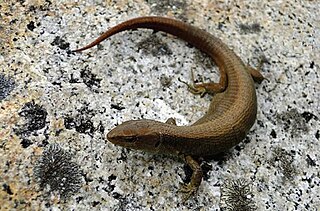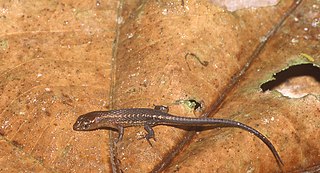Anotosaura is a genus of South American lizards in the family Gymnophthalmidae.

Cercosaura is a genus of lizards in the family Gymnophthalmidae. The genus is endemic to South America.
Colobosauroides is a small genus of lizards in the family Gymnophthalmidae. The genus Colobosauroides is endemic to Brazil.

Euspondylus is a genus of lizards in the family Gymnophthalmidae.
Macropholidus is a genus of lizards in the family Gymnophthalmidae. The genus is endemic to South America.

Neusticurus is a genus of gymnophthalmid lizards endemic to northern South America. They are often found near streams and are semi-aquatic. Some species formerly included in this genus are now placed in Potamites, which also are semi-aquatic inhabitants of South America.
The Key tegu is a species of lizard in the family Gymnophthalmidae. The species is endemic to Ecuador.
Proctoporus xestus, or the river teiid, is a species of lizard in the family Gymnophthalmidae. The species is endemic to South America.
Gelanesaurus is a genus of lizards in the family Gymnophthalmidae. The genus contains two species, which are native to Colombia and Ecuador. Both species were included in the genus Potamites until 2016 when they were moved to the genus Gelanesaurus.

Riama is a genus of lizards in the family Gymnophthalmidae. The genus is endemic to South America.
Kaieteurosaurus is a genus of lizard in the family Gymnophthalmidae. The genus is monotypic, i.e., it has only one species, Kaieteurosaurus hindsi. It is endemic to Guyana where it is known from the Kaieteur National Park.
Selvasaura is a genus of the lizard family Gymnophthalmidae. The genus contains three species.
Anotosaura vanzolinia, also known commonly as Vanzolini's anotosaura, is a species of lizard in the family Gymnophthalmidae. The species is endemic to Brazil.
Bachia pyburni is a species of lizard in the family Gymnophthalmidae. The species is endemic to northern South America.
Echinosaura orcesi is a species of lizard in the family Gymnophthalmidae. The species is endemic to northwestern South America.
Loxopholis ferreirai is a species of lizard in the family Gymnophthalmidae. The species is endemic to Brazil.
Neusticurus medemi, also known commonly as Medem's neusticurus, is a species of lizard in the family Gymnophthalmidae. The species is native to northern South America.

Alopoglossus angulatus, known commonly as the northern teiid, is a species of lizard in the family Alopoglossidae. The species is endemic to northern South America.
Alopoglossus atriventris, known commonly as the keel-bellied shade lizard, is a species of lizard in the family Alopoglossidae. The species is endemic to northwestern South America.
Alopoglossus lehmanni is a species of lizard in the family Alopoglossidae. The species is endemic to western Colombia.




